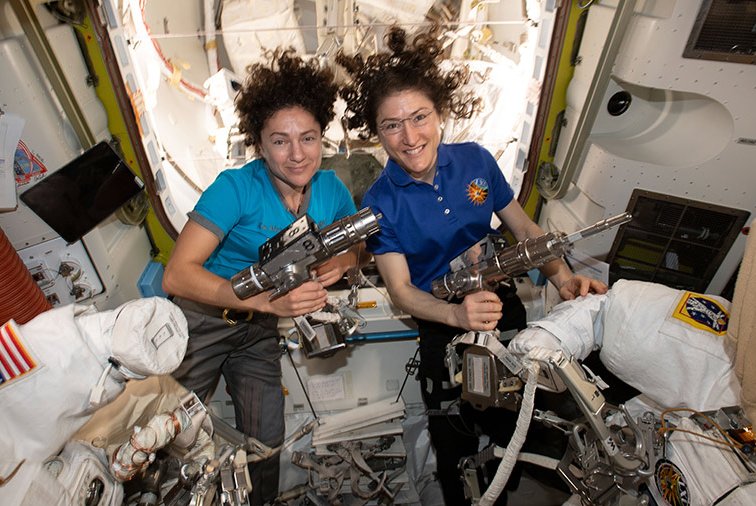NASA astronauts Jessica Meir (L) and Christina Koch go inside the Quest airlock to prepare the spacesuits and tools they will use on their first spacewalk together. Photo by NASA
Oct. 17 (UPI) -- Officials and astronauts at NASA recognize the historical significance of Friday's spacewalk to replace battery system hardware -- it is the first to feature an all-female repair team.
Astronauts Jessica Meir and Christina Koch are scheduled to conduct an extravehicular activity, or EVA, to replace a failed battery charge-discharge unit on the International Space Station.
The units regulate the amount of charge put into each of the station's batteries.
With five spacewalks scheduled for October, the potential was thought to be high for two women to venture outside the International Space Station, though Meir has downplayed it.
"Everyone up here is fully qualified to do a spacewalk," Meir told reporters during a video conference earlier this month.
But when the pair step outside for the spacewalk, they will make history.
Second attempt
Friday's historic spacewalk was supposed to occur in March. Astronaut Anne McClain was scheduled to help Koch replace old batteries with new lithium ion batteries.
"Anne and Christina will have the opportunity to be the first all-female EVA, which I think will be a proud moment for NASA if the assignments stay as they planned," Mary Lawrence, a NASA spacewalk flight director, said during a March 19 press conference.
"If they inspire that next generation of space explorers, they're certainly worthy of that inspiration, and I'm just really proud to be a part of it."
But when McClain decided the large spacesuit she wore during her first spacewalk was not the right fit, and that she would feel more comfortable in the medium size, NASA officials nixed the history-making mission. Only one medium spacesuit existed, and Koch needed that size, too.
This time around, the necessary spacesuits are available, though all those involved have somewhat downplayed the walk's significance.
"Based on workload, [it] makes sense for the women to do their spacewalk" this week, Megan McArthur, deputy chief of NASA's Astronaut Office, told reporters Tuesday.
NASA doesn't consider gender when planning spacewalks, she said: "This was the right crew to send out for this set of tasks. The fact that it'll be two women is just a reflection that we have so many qualified women in the office."
Focus on the mission
Margaret A. Weitekamp, curator and department chairwoman of the space history department at the Smithsonian Air and Space Museum, said she's not surprised by the business-as-usual approach to the historic mission.
"For those us who've quietly speculated about when this milestone might happen -- because we're interested in women in space -- we agreed that it would happen because there was the right opportunity, the right spacesuits, the right mission and the right personnel, not because there was publicity to be gained," Weitekamp told UPI. "It does speak in some ways to maturity in human space flight."
NASA and its astronauts do recognize the significance of the mission, particularly as it relates to inspiring young women.
"There are a lot of people that derive motivation from inspiring stories about people that look like them, and I think that is an important aspect of the story to tell," astronaut Koch told reporters earlier this month.
"What we're doing now shows all that work went into it to get us where we are today," astronaut Meir said. "And the nice thing about it for us is that we don't really think about it on a day-to-day basis."
Most visible faces
All that work included dozens of earlier milestones, including Sally Ride's ceiling-busting ride aboard the shuttle Challenger in 1983, when she became the first woman to travel in space. A year later, Soviet cosmonaut Svetlana Savitskaya became the first woman to participate in a spacewalk.
That same year, 1984, NASA astronaut Kathryn D. Sullivan became the first American woman to conduct an extravehicular mission when she floated outside Challenger.
And of course, there's NASA astronaut Peggy Whitson, owner of many milestones and records.
Whitson became the first woman to serve as commander of the International Space Station in 2008. She held the leadership position again in 2016. She retired from life as an astronaut as the oldest woman in space, when she conducted her final space station mission at 57.
Koch will break Whitson's 288-day record for longest spaceflight by a female with her current flight, scheduled to end in February.
Behind every visible space flight milestone, there is a lot of hard work behind the scenes -- work that is assisted by the talents of a diverse workforce.
"The astronauts corps has always been the most visible face of NASA's space flight mission," Weitekamp said. "But most of the work that gets done in human space flight gets done on the ground, and I think that NASA as an agency has worked hard to be more inclusive and encouraged young women to pursue those broader engineering and space science careers."















